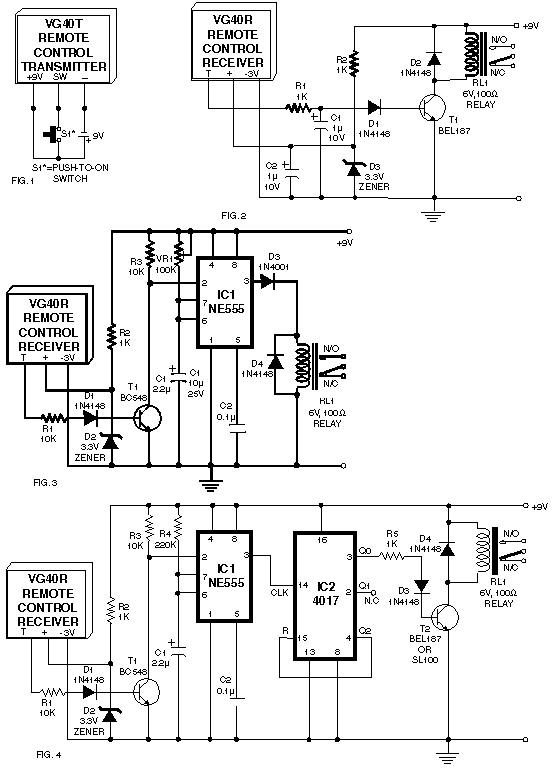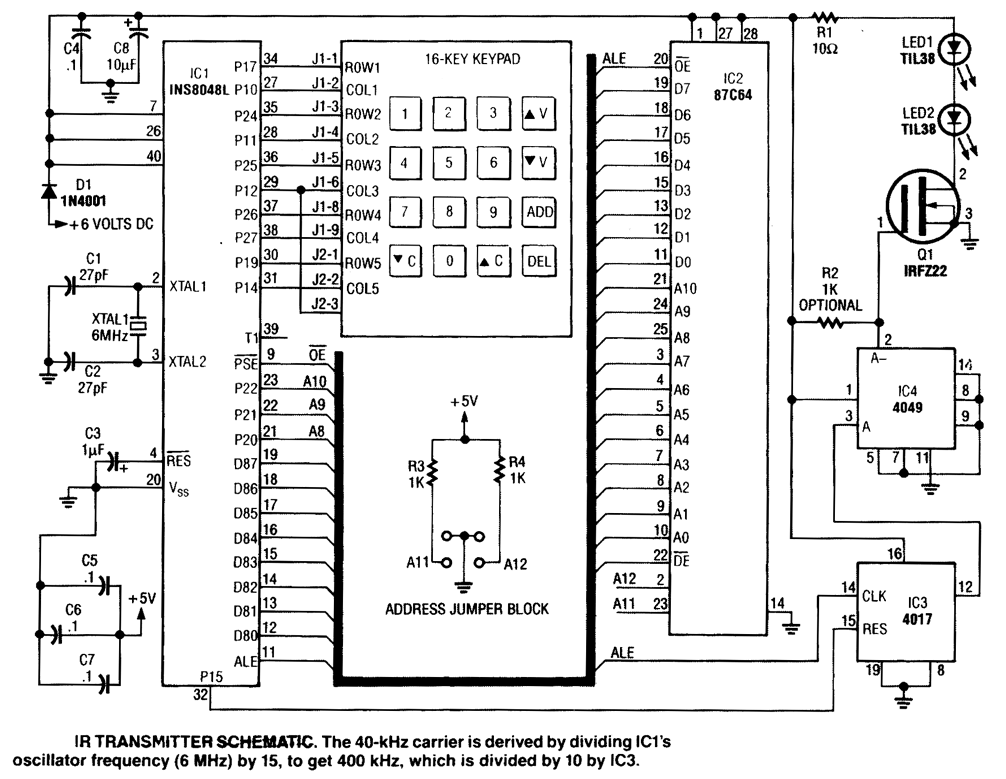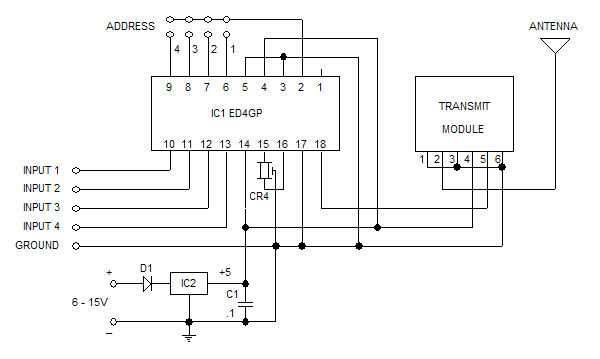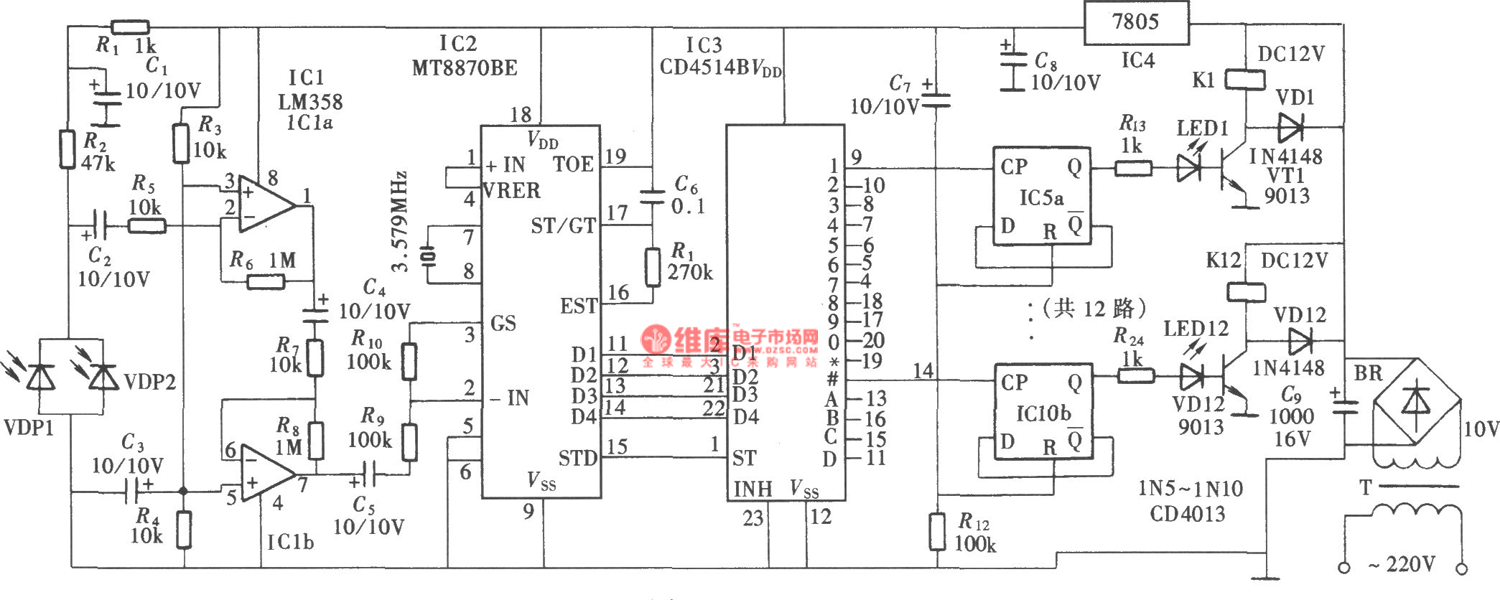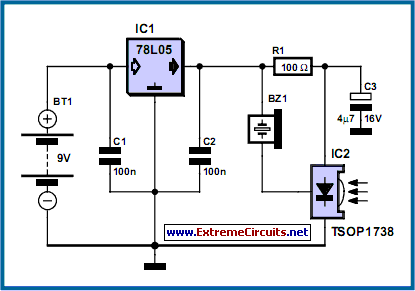
FM remote Encoder/Decoder
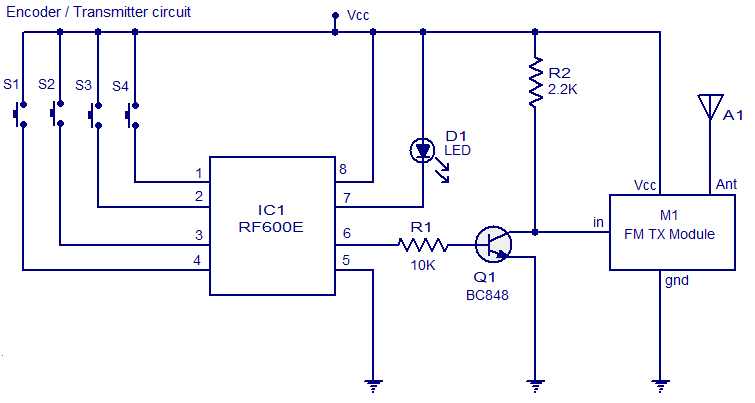
The circuit diagram illustrates an FM remote encoder/decoder utilizing the RF600E and RF600D integrated circuits (ICs). These components are engineered to deliver a high level of security and operate within a voltage range of 2 to 6.6V DC. Applications for the RF600E/RF600D include various electronic systems such as remote control systems, remote alarm systems, and anti-theft alarms. The remote systems described utilize FM for transmission. The encoder circuit is formed by IC1 RF600E and its associated components. Pins 1 to 4 serve as switch inputs for IC1. When a push button switch is activated, a corresponding code is generated at pin 6, which functions as the data output pin. The encoded signal at pin 6 is buffered by transistor Q1 and sent to the input of a general-purpose FM transmitter module (M1), which is widely available in the market. The decoder system consists of IC2 RF600D and its associated components. Pins 17, 18, 1, and 2 are the digital data output pins of RF600D corresponding to the input switches S1 to S4 of the encoder/transmitter circuits. The digital data output pins 17, 18, 1, and 2 are asserted low when the relevant inputs S1 to S4 on IC2 RF600E are activated. M2 is a general-purpose FM receiver module that receives the transmitted code and feeds it to the data input (pin 9) of IC2. Switch S1 allows for selection between latching and momentary digital output functions. In latching mode, the digital output pins (OP1 to OP4) are asserted only for the corresponding transmit signal, with the output state changing on each corresponding transmit signal. The learn switch S5 is employed to place the decoder IC into learn mode. The learning operation using push button switch S5 proceeds as follows: 1) Press and release push button switch S5. 2) The status LED D2 will illuminate when S5 is pressed and remain ON upon release. 3) Activate the encoder/transmitter once. 4) The status LED D2 will turn OFF. 5) Activate the encoder/transmitter again. 6) The status LED will begin flashing. 7) Once the flashing of the status LED ceases, the encoder will have been successfully programmed to the decoder, and the transmitter/encoder will now operate the receiver/decoder system. Up to seven encoder/transmitters can be programmed to each RF600D. Pin 3 of IC2 serves as the transmitter low battery indicator output, while pin 11 is designated as the serial data output.
The FM remote encoder/decoder circuit is a sophisticated system designed to facilitate wireless communication with a focus on security applications. The RF600E IC, functioning as the encoder, converts the input signals from the push button switches into a coded output. Each switch corresponds to a specific function, enabling control over various devices remotely. The buffering of the encoded signal through transistor Q1 ensures that the signal strength is adequate for transmission, minimizing the risk of data loss.
The FM transmitter module (M1) plays a crucial role in the circuit, as it modulates the encoded signal onto a carrier frequency suitable for FM transmission. This allows for reliable communication over distances, making it ideal for applications such as remote control systems and alarm systems. The choice of a general-purpose FM transmitter module enhances the flexibility of the design, enabling easy sourcing and integration.
On the receiving end, the RF600D IC decodes the received FM signal. The digital data output pins provide a direct interface to control other electronic components or systems based on the received commands. The ability to switch between latching and momentary output functions adds versatility to the system, catering to different operational requirements.
The learning feature of the system, facilitated by switch S5, allows for easy integration of multiple transmitters. This capability is particularly useful in applications requiring multiple remote controls, such as home automation or security systems. The visual feedback from the status LED D2 during the learning process ensures that users can easily understand the system's state, simplifying the setup procedure.
Overall, this FM remote encoder/decoder circuit represents a robust solution for wireless control applications, leveraging the capabilities of RF600E and RF600D ICs to provide a secure and efficient communication method.Here is the circuit diagram of an FM remote encoder/decoder using the ICs RF600E and RF600D. These devices are designed to provide a high level of security and operates from anything between 2 to 6. 6V DC. Various electronic circuits like remote control systems, remote alarm systems, anti theft alarms etc can be implemented using the RF600E/RF600D
pair. The remote systems given here uses FM for the transmission. IC1 RF600E and its associated components form the encoder circuit. Pins 1 to 4 forms the switch inputs of IC1. When each push button switch is pressed a corresponding code will be generated at the pin 6 which is the data output pin. The encoded signal available at pin 6 is buffered using the transistor Q1 and the fed to the input of a general purpose FM transmitter module (M1).
Such FM transmitter modules are very common in the market now. The decoder system comprises of the IC2 RF600D and its associated components. Pins 17, 18, 1 and 2 are the digital data output pins of RF600D corresponding to the input switches S1 to S4 of the encoder/transmitter circuits. The digital data output pins 17, 18, 1 and 2 are asserted low when the relevant inputs S1 to S4 on the IC2 RF600E are asserted.
M2 is a general purpose FM receiver module which receives the transmitted code and feds it to the data input (pin 9) of the IC2. Switch S1 can be used to select between latching and momentary digital output function. In latching mode digital output pins (OP1 to OP4) are only asserted for the corresponding transmit signal.
In latching mode the output state is changed on each corresponding transmit signal. The learn switch S5 is used to enter the decoder IC in to the learn mode . Learn operation using push button switch S5 is as follows. 1) Press and release the push button switch S5. 2) The status LED D2 will glow when S5 is pressed and will remain ON when S5 is released. 3) Operate the encoder/transmitter once. 4) The status LED D2 will become OFF. 5) Operate the encoder/transmitter again. 6) The status LED will start flashing. 7) When the flashing of status LED stops, the encoder will be successfully taught to the decoder and the transmitter/encoder will now operate the receiver/decoder system. Up to seven encoder/transmitters can be learnt to each RF600D. Pin 3 of IC2 is the transmitter low battery indicator output and pin 11 is the serial data output. 🔗 External reference
The FM remote encoder/decoder circuit is a sophisticated system designed to facilitate wireless communication with a focus on security applications. The RF600E IC, functioning as the encoder, converts the input signals from the push button switches into a coded output. Each switch corresponds to a specific function, enabling control over various devices remotely. The buffering of the encoded signal through transistor Q1 ensures that the signal strength is adequate for transmission, minimizing the risk of data loss.
The FM transmitter module (M1) plays a crucial role in the circuit, as it modulates the encoded signal onto a carrier frequency suitable for FM transmission. This allows for reliable communication over distances, making it ideal for applications such as remote control systems and alarm systems. The choice of a general-purpose FM transmitter module enhances the flexibility of the design, enabling easy sourcing and integration.
On the receiving end, the RF600D IC decodes the received FM signal. The digital data output pins provide a direct interface to control other electronic components or systems based on the received commands. The ability to switch between latching and momentary output functions adds versatility to the system, catering to different operational requirements.
The learning feature of the system, facilitated by switch S5, allows for easy integration of multiple transmitters. This capability is particularly useful in applications requiring multiple remote controls, such as home automation or security systems. The visual feedback from the status LED D2 during the learning process ensures that users can easily understand the system's state, simplifying the setup procedure.
Overall, this FM remote encoder/decoder circuit represents a robust solution for wireless control applications, leveraging the capabilities of RF600E and RF600D ICs to provide a secure and efficient communication method.Here is the circuit diagram of an FM remote encoder/decoder using the ICs RF600E and RF600D. These devices are designed to provide a high level of security and operates from anything between 2 to 6. 6V DC. Various electronic circuits like remote control systems, remote alarm systems, anti theft alarms etc can be implemented using the RF600E/RF600D
pair. The remote systems given here uses FM for the transmission. IC1 RF600E and its associated components form the encoder circuit. Pins 1 to 4 forms the switch inputs of IC1. When each push button switch is pressed a corresponding code will be generated at the pin 6 which is the data output pin. The encoded signal available at pin 6 is buffered using the transistor Q1 and the fed to the input of a general purpose FM transmitter module (M1).
Such FM transmitter modules are very common in the market now. The decoder system comprises of the IC2 RF600D and its associated components. Pins 17, 18, 1 and 2 are the digital data output pins of RF600D corresponding to the input switches S1 to S4 of the encoder/transmitter circuits. The digital data output pins 17, 18, 1 and 2 are asserted low when the relevant inputs S1 to S4 on the IC2 RF600E are asserted.
M2 is a general purpose FM receiver module which receives the transmitted code and feds it to the data input (pin 9) of the IC2. Switch S1 can be used to select between latching and momentary digital output function. In latching mode digital output pins (OP1 to OP4) are only asserted for the corresponding transmit signal.
In latching mode the output state is changed on each corresponding transmit signal. The learn switch S5 is used to enter the decoder IC in to the learn mode . Learn operation using push button switch S5 is as follows. 1) Press and release the push button switch S5. 2) The status LED D2 will glow when S5 is pressed and will remain ON when S5 is released. 3) Operate the encoder/transmitter once. 4) The status LED D2 will become OFF. 5) Operate the encoder/transmitter again. 6) The status LED will start flashing. 7) When the flashing of status LED stops, the encoder will be successfully taught to the decoder and the transmitter/encoder will now operate the receiver/decoder system. Up to seven encoder/transmitters can be learnt to each RF600D. Pin 3 of IC2 is the transmitter low battery indicator output and pin 11 is the serial data output. 🔗 External reference
